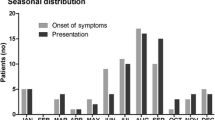Abstract
The cerebrospinal fluid (CSF) of 37 patients with early Lyme neuroborreliosis (ELN) and of 10 patients with late Lyme neuroborreliosis (LLN, duration of symptoms ≥ 7 months) was investigated for typical features differentiating between acute and chronic courses of disease. Individual patients were studied after 2 and 4 weeks, and 3, 6, and 12 months. Patients with ELN presented predominantly with symptoms of the peripheral nervous system, while patients with LLN generally suffered from symtoms of the central nervous system. At the first lumbar puncture, patients with ELN revealed a more intense pleocytosis in the CSF (P < 0.02) and a higher intrathecal synthesis of total IgM (P < 0.0003) and ofBorrelia burgdorferi-specific IgM antibodies (P < 0.01). At the same time, in patients with LLN, the blood-CSF barrier was more severely impaired (P = 0.03), and local production of total IgG (P = 0.0001), ofB. burgdorferi-specific IgG antibodies (P = 0.03) and of total IgA (P = 0.001) was more markedly increased. The quantity of intrathecally producedB. burgdorferi-specific IgA antibodies did not differ between the two study groups. Clinical recovery was usually accompanied by a considerable improvement of the blood-CSF barrier function and pleocytosis. After 6 months, the intrathecal synthesis of total IgG had significantly decreased in patients with ELN but not in those with LLN. At the same time, the CSF of most patients in both study groups still contained intrathecally producedB. burgdorferi-specific IgG antibodies. In the absence of clinical illness or symptoms of inflammation 6 and 12 months after treatment,B. burgdorferi-specific IgG antibodies in the CSF might simply indicate an anamnestic reaction to a previous infection of the central nervous system. Six months after antibiotic treatment, patients with ELN still revealed evidence of intrathecal synthesis of total IgM, whereas those with LLN did not. These antibodies, however, were not related toB. burgdorferi.
Similar content being viewed by others
References
Ackermann R, Rehse-Küpper B, Gollmer E, Schmidt R (1988) Chronic neurologic manifestations of erythema migrans borreliosis. Ann NY Acad Sci 539:16–23
Asbrink E, Hovmark A (1988) Early and late cutaneous manifestations ofIxodes-borne borreliosis (erythema migrans borreliosis, Lyme borreliosis). Ann NY Acad Sci 539:4–15
Barbour AG (1984) Isolation and cultivation of Lyme disease spirochetes. Yale J Biol Med 57:521–525
Felgenhauer K, Schädlich H-J (1987) The compartmental IgM and IgA response within the central nervous system. J Neurol Sci 77:125–135
Finkel M (1988) Lyme disease and its neurologic complications. Arch Neurol 45:99–104
Halperin JJ, Volkman DJ, Wu P (1991) Central nervous system abnormalities in Lyme neuroborreliosis. Neurology 41:1571–1582
Hammers-Berggren S, Hansen K, Lebech A-M, Karlsson M (1993)Borrelia burgdorferi-specific intrathecal antibody production in neuroborreliosis: A follow-up study. Neurology 43:69–175
Henriksson A, Link H, Cruz M, Stiernstedt G (1986) Immunoglobulin abnormalities in cerebrospinal fluid and blood over the course of lymphocytic meningoradiculitis (Bannwarth's syndrome). Ann Neurol 20:337–345
Kaiser R, Lucking CH (1993) Intrathecal synthesis of specific antibodies in neuroborreliosis. Comparison of different ELISA techniques and calculation methods. J Neurol Sci 118:64–72
Kaiser R, Lucking CH (1993) Intrathecal synthesis of IgM and IgA in neurological diseases: comparison of two formulae with the isoelectric focusing. Clin Chim Acta 216:39–51
Lebech A-M, Hansen K (1992) Detection ofBorrelia burgdorferi DNA in urine samples and CSF samples from patients with early and late Lyme neuroborreliosis by polymerase chain reaction. J Clin Microbiol 30:1646–1653
Logigian EL, Kaplan RF, Steere AC (1990) Chronic neurologic manifestations of Lyme disease. N Engl J Med 323:1438–1444
Martin R, Martens U, Sticht-Groh V, Dörries R, Krüger H (1988) Persistent intrathecal secretion of oligoclonalBorrelia burgdorferi-specific IgG in chronic menigoradiculomyelitis. J Neurol 235:229–233
Müller F, Moskophidis M, Borkhardt HL (1987) Detection of immunoglobulin M antibodies toTrepouema pallidum in a modified enzyme-linked immunosorbent assay. Eur J Clin Microbiol 6:35–39
Nossal GJ, Szenberg A, Ada GL, Austin CM (1964) Single cell studies on 19S antibody production. J Exp Med 119:485–502
Rehse-Küpper B, Ackermann R (1986) Demonstration of locally synthesizedBorrelia antibodies in cerebrospinal fluid. Zentralbl Bakteriol Hyg [A] 263:407–411
Reiber HO (1988) Aktuelle Methoden der Liquoranalytik. Lab Med 12:101–109
Reiber HO, Felgenhauer K (1987) Protein transfer at the blood cerebrospinal fluid barrier and the quantitation of the Immoral immune response within the central nervous system. Clin Chim Acta 163:319–328
Reiber HO, Lange P, (1991) Quantitation of virus-specific antibodies in cerebrospinal fluid and serum: sensitive and specific detection of antibody synthesis in brain. Clin Chem 37:1153–1160
Steere AC (1989) Lyme disease. N Engl J Med 321:586–596
Steere AC, Berardi VP, Weeks KE, Logigian EL, Ackermann R (1990) Evaluation of the intrathecal antibody response toBorrelia burgdorferi as a diagnostic test for Lyme neuroborreliosis. J Infect Dis 161:1203–1209
Stiernstedt GT, Sköldenberg BR, Vandvik B, Hederstedt B, Garde A, Kolmodin G, Jöbäck H, Sbenungsson B (1984) Chronic meningitis and Lyme disease in Sweden. Yale J Biol Med 57:491–497
Weder B, Wiedersheim P, Matter L, Steck A, Otto F (1987) Chronic progressive neurological involvement inBorrelia burgdorferi infection. J Neurol 234:40–43
Wilske B, Schierz G, Preac-Mursic V, Busch K, Kühbeck R, Pfister HW, Einhdupl K (1986) Intrathecal production of specific antibodies againstBorrelia burgdorferi in patients with lymphocytic meningoradiculitis (Bannwarth's syndrome). J Infect Dis 153:304–314
Yang L, Ma Y, Schoenfeld R, Griffiths M, Eichwald E, Araneo B, Weis JJ (1992) Evidence for B-lymphocyte mitogen activity inBorrelia burgdorferi-infected mice. Infect Immun 60:3033–3041
Author information
Authors and Affiliations
Rights and permissions
About this article
Cite this article
Kaiser, R. Variable CSF findings in early and late Lyme neuroborreliosis: A follow-up study in 47 patients. J Neurol 242, 26–36 (1994). https://doi.org/10.1007/BF00920571
Received:
Revised:
Accepted:
Issue Date:
DOI: https://doi.org/10.1007/BF00920571




